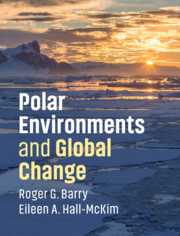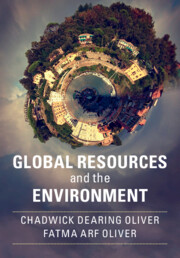Refine listing
Actions for selected content:
2285 results in Ebooks in ecology and environment
Acknowledgments
-
- Book:
- Polar Environments and Global Change
- Published online:
- 27 July 2018
- Print publication:
- 09 August 2018, pp xxvi-xxvi
-
- Chapter
- Export citation
9 - Future Environments in the Polar Regions
-
- Book:
- Polar Environments and Global Change
- Published online:
- 27 July 2018
- Print publication:
- 09 August 2018, pp 378-400
-
- Chapter
- Export citation
Preface
-
- Book:
- Polar Environments and Global Change
- Published online:
- 27 July 2018
- Print publication:
- 09 August 2018, pp xxv-xxv
-
- Chapter
- Export citation
About the Authors
-
- Book:
- Polar Environments and Global Change
- Published online:
- 27 July 2018
- Print publication:
- 09 August 2018, pp xxi-xxiv
-
- Chapter
- Export citation

Polar Environments and Global Change
-
- Published online:
- 27 July 2018
- Print publication:
- 09 August 2018

Global Resources and the Environment
-
- Published online:
- 05 July 2018
- Print publication:
- 21 June 2018
Part V - Biodiversity
-
- Book:
- Global Resources and the Environment
- Published online:
- 05 July 2018
- Print publication:
- 21 June 2018, pp 191-262
-
- Chapter
- Export citation
13 - Biodiversity: Individual Species
- from Part V - Biodiversity
-
- Book:
- Global Resources and the Environment
- Published online:
- 05 July 2018
- Print publication:
- 21 June 2018, pp 193-210
-
- Chapter
- Export citation
Part VI - Water
-
- Book:
- Global Resources and the Environment
- Published online:
- 05 July 2018
- Print publication:
- 21 June 2018, pp 263-310
-
- Chapter
- Export citation
Preface
-
- Book:
- Global Resources and the Environment
- Published online:
- 05 July 2018
- Print publication:
- 21 June 2018, pp xv-xvii
-
- Chapter
- Export citation
Appendix I - Country Groups Used in Analyses
-
- Book:
- Global Resources and the Environment
- Published online:
- 05 July 2018
- Print publication:
- 21 June 2018, pp 492-495
-
- Chapter
- Export citation
Copyright page
-
- Book:
- Global Resources and the Environment
- Published online:
- 05 July 2018
- Print publication:
- 21 June 2018, pp iv-iv
-
- Chapter
- Export citation
Part VIII - Energy
-
- Book:
- Global Resources and the Environment
- Published online:
- 05 July 2018
- Print publication:
- 21 June 2018, pp 363-406
-
- Chapter
- Export citation
23 - Energy Sources, the Energy Cycle, Exergy
- from Part VIII - Energy
-
- Book:
- Global Resources and the Environment
- Published online:
- 05 July 2018
- Print publication:
- 21 June 2018, pp 365-374
-
- Chapter
- Export citation
18 - Annual Hydrographs and Water Use
- from Part VI - Water
-
- Book:
- Global Resources and the Environment
- Published online:
- 05 July 2018
- Print publication:
- 21 June 2018, pp 283-297
-
- Chapter
- Export citation
11 - Bedrock Landforms
- from Part IV - Landforms
-
- Book:
- Global Resources and the Environment
- Published online:
- 05 July 2018
- Print publication:
- 21 June 2018, pp 157-169
-
- Chapter
- Export citation
10 - Landforms and Soils
- from Part IV - Landforms
-
- Book:
- Global Resources and the Environment
- Published online:
- 05 July 2018
- Print publication:
- 21 June 2018, pp 137-156
-
- Chapter
-
- You have access
- HTML
- Export citation
Part XI - Perspective
-
- Book:
- Global Resources and the Environment
- Published online:
- 05 July 2018
- Print publication:
- 21 June 2018, pp 483-491
-
- Chapter
- Export citation
4 - How People Communicate and Interact
- from Part II - People
-
- Book:
- Global Resources and the Environment
- Published online:
- 05 July 2018
- Print publication:
- 21 June 2018, pp 35-46
-
- Chapter
- Export citation
8 - Greenhouse Gases, Atmosphere, and Climates
- from Part III - Climates
-
- Book:
- Global Resources and the Environment
- Published online:
- 05 July 2018
- Print publication:
- 21 June 2018, pp 103-115
-
- Chapter
- Export citation
